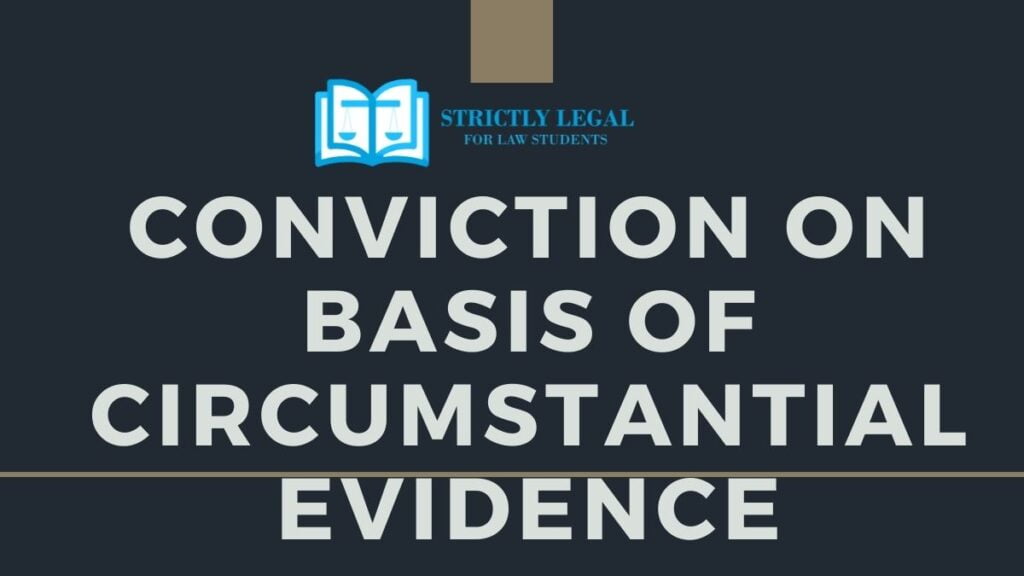The term “Circumstantial Evidence” is specifically vital in the Law of Evidence. Circumstantial Evidence is inclusive of all the relevant facts. It is not a shred of secondary evidence but it is merely direct evidence. It is evidence applied indirectly.
In other terms, it is a fact that is put before the court, and the fact itself does not tell anything about the offense or course of action. However, it accords and helps the Court to come to a certain decision or make some assumptions that may be very minutely close to the facts.
Table of Contents
Understanding the Concept of Circumstantial Evidence
Circumstantial Evidence is connected to the circumstances of the case. It is also known as indirect evidence as it is applicable indirectly. It is inclusive of all the relevant facts and it is NOT a secondary evidence.
Essentials of a Circumstantial Evidence
Evidence plays a vital role in delivering justice may it be a criminal case or civil. It becomes highly important that a shred of evidence produced in the court shall be taken care of.
In order to take an evidence into consideration, it shall fulfill certain criteria, which are as follows:
- The guilt established from the circumstance must be proved.
- Circumstances must be conclusive in nature and tendency.
- The guilt of the accused must be proved beyond a reasonable doubt.
Circumstantial Evidence- A solitary basis of conviction
The depth that a shred of circumstantial evidence holds is way more different and far away from what is called “perfect” that we are shown in courtroom dramas in the Bollywood movies. The circumstantial evidence is that which when examined in isolation may be like just another fact but when scrutinized the same to its relevance to the facts in issue or disproves the facts in question.
There is a well-known misapprehension that circumstantial evidence is not necessary or less important than direct evidence. That is not entirely true. Circumstantial evidence is necessary and at times it is more powerful than any other evidence. Usually, circumstantial evidence is more privileged than direct evidence as it is a bit hard to suppress or forge direct evidence.
It is a well-known fact that a confession coming from an accused is the best evidence, if it is voluntary, without any pressure from any authorities.
After considering the evidence presented and hearing the argument, the court concludes that if the facts exist or not and which have been declared by the parties. The court applies rule of law after finding all the facts.
Difference between Direct Evidence and Circumstantial Evidence
| DIRECT EVIDENCE | CIRCUMSTANTIAL EVIDENCE |
| The evidence which corroborates a fact and the conjecture of the jury is not required. | This is the shred of evidence where the jury has to conjecture based on the facts drawn out that may link to the conclusion. |
| It is based on personal knowledge of the witness or the monitoring of the fact. | It is based on fact from which existing or imaginary of another fact can be reasonable conjectured. |
| Used for facts in issue. | Used for series of related facts. |
| When the judge is pleased with the evidence beyond any reasonable doubt of the respondent’s guilt. | When the evidence does not prove any guilt but brings about a conjecture of guilt, which is beyond a reasonable doubt. |
Well known precedent on Circumstantial Evidenc
- The very well-known and high-class murder case of Jesicca Lal in the case of Siddharth Vasishta alias Manu Sharma v. NCT of Delhi [2010 (69) ACC 833 (SC)], which triggered the whole country is a fluorescent illustration of Circumstantial Evidence. Jessica Lal, a bartender, denied serving alcohol to the accused petitioner for the bar being closed at the point of time and was shot dead thereafter. The accused petitioner was scurrying but later surrendered himself to the Chandigarh Police. The accused confessed his crime but later turned hostile in the Court sessions on account of the developments of the case in which the trial court acquitted him. Nonetheless, was a mutiny in the Indian Justice System after the conviction of Manu Sharma, as the then President of India received applications from across the country to re-investigate the accused petitioner. The Delhi High Court decided to go forward with the circumstantial evidence that the Manu Sharma was present on the day of the murder at the bar and the ballistic reports said that the bullet fired from the gun showed involvement of Manu Sharma in the murder.
- In the case of Bodh Raj v. the State of Jammu and Kashmir [018 (3) CRIMES 377 (J&K) ], the Honorable Court decided that circumstantial evidence can be a sole basis for conviction provided the conditions specified below are proved and satisfied to the best of its knowledge:
- The Circumstance from which guilt is habituated must be entirely proved.
- That all the facts must be accordant with the hypothesis of the guilt of the accused.
- That the circumstances must be of a irrefutable nature and tendency.
- That the circumstances should to moral confidence, actually debar every hypothesis except the one proposed to be proved.
Conclusion
The whole discussion, especially after reading the paper brings us back to the basic question popping into our heads whether circumstantial evidence can be a solitary reason for conviction or not. Undoubtedly, it can be the solitary reason for conviction as it plays a vital role in criminal cases that sometimes, laboriously depend on the circumstantial evidence. A well-known misconception all of us have is circumstantial evidence is less necessary or valid than direct evidence, whereas this is only partially true. True that direct evidence makes a case stronger to make any judgment or conviction but successful criminal prosecutions often depend to a large extent on the circumstances. In litigation, circumstantial evidence is more meritorious than direct evidence as it is almost impossible to fabricate them.

Law student.
Turning legal insights into engaging narratives.




